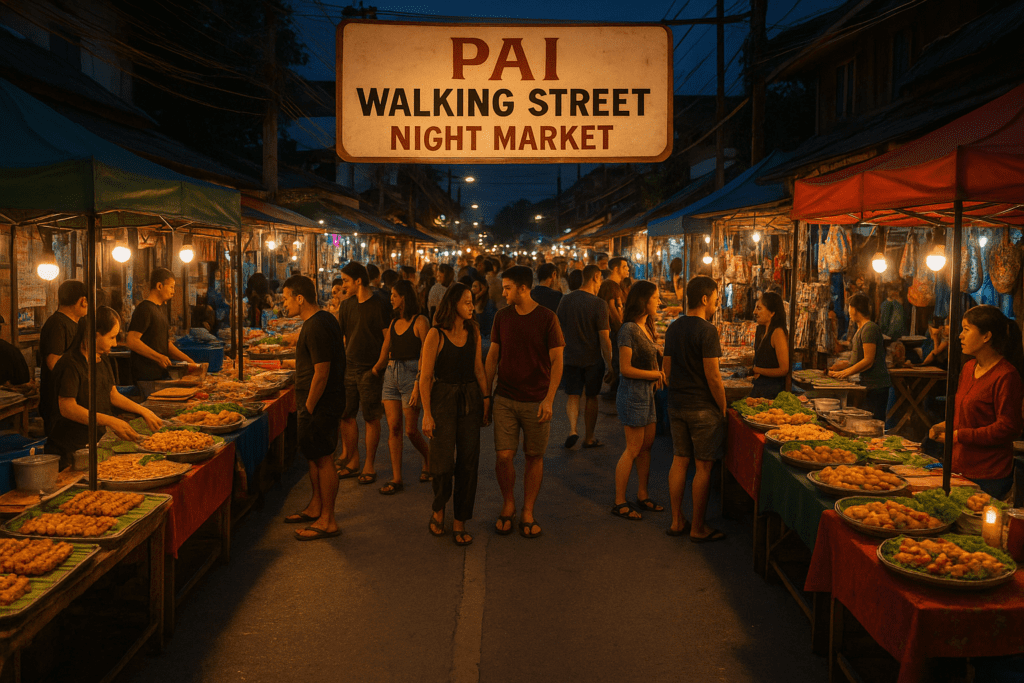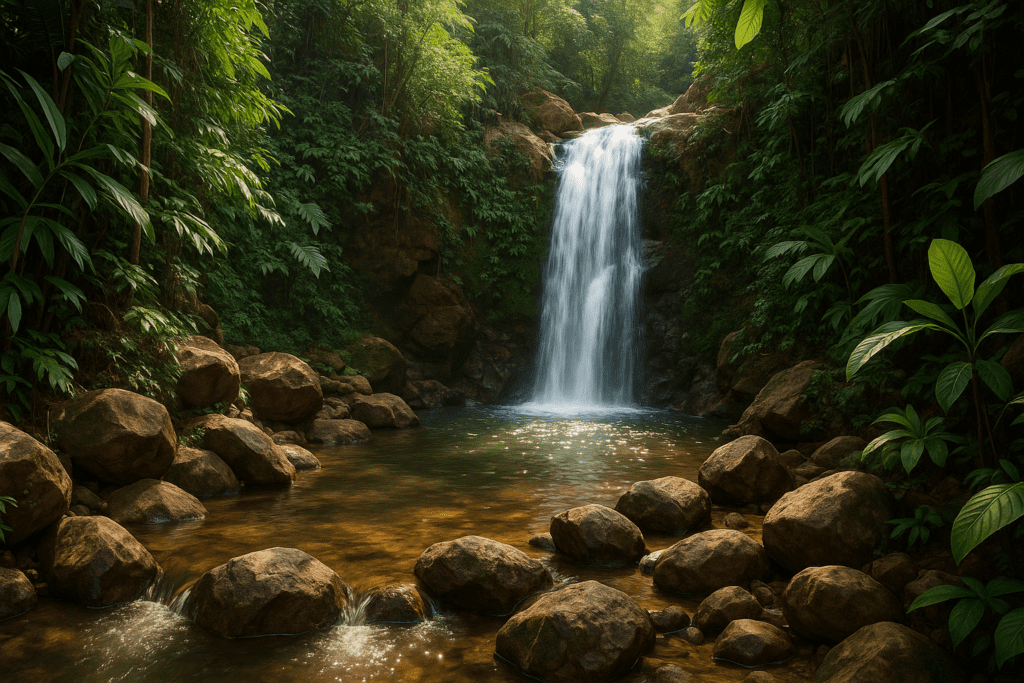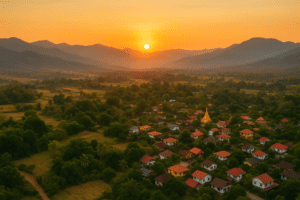Estimated reading time: 12 minutes
Key Takeaways
- Pai is a magical mountain town in northern Thailand perfect for backpackers, couples, and nature lovers
- The best time to visit is during cool season (November-February) for ideal weather and clear skies
- Getting to Pai from Chiang Mai involves a scenic 3-4 hour journey through 762 mountain curves
- Top activities include hiking Pai Canyon at sunset, exploring night markets, and visiting waterfalls
- A 3-day itinerary allows you to experience the main attractions without feeling rushed
- Pai is extremely budget-friendly with affordable accommodation, food, and activities
- Renting a scooter provides the ultimate freedom to explore the stunning countryside
Table of Contents
- Is Pai Worth Visiting? The Honest Verdict
- What is the Best Time to Visit Pai? A Seasonal Breakdown
- How to Get to Pai from Chiang Mai: Navigating the 762 Curves
- Know Before You Go: Essential Pai Travel Tips
- Top 10 Unforgettable Things to Do in Pai
- The Perfect Pai Itinerary (3 Days)
- Your Ultimate Pai Backpacker Guide: Budget, Stays & Socializing
- Conclusion: Your Pai Adventure Awaits

Nestled in Thailand’s northern Mae Hong Son province, Pai is a magical mountain town that has captured the hearts of travelers worldwide with its bohemian spirit, misty valleys, and irresistibly laid-back allure. This former quiet rural outpost has evolved into a beloved destination where backpackers, couples, and nature enthusiasts find their perfect slice of Thai paradise.
This comprehensive Pai Thailand travel guide will cover everything you need to know for planning your trip, from practical logistics to hidden local gems. We’ll walk you through the best times to visit, transportation options, must-see attractions, and insider tips that will help you make the most of your time in this enchanting mountain retreat.
If you’re wondering whether this charming town should be on your Thailand itinerary and asking yourself, is Pai worth visiting, then you’re in the right place. Read on to discover everything Pai has to offer and why it deserves a spot on your Southeast Asian adventure.

Is Pai Worth Visiting? The Honest Verdict
Yes, absolutely – but it depends on what you’re looking for in a travel experience. Pai delivers something special for different types of travelers, making it a remarkably versatile destination that consistently exceeds expectations.
For Backpackers: Pai has earned its reputation as a staple on the Southeast Asia backpacking circuit, thanks to its relaxed atmosphere, abundance of affordable hostels, and incredibly active social scene. The communal guesthouses and bustling night markets create natural opportunities for meeting fellow travelers from around the world. Learn more about backpacking in Pai on Nomadic Matt’s travel blog, where you’ll find detailed budget breakdowns and hostel recommendations.
For Couples: The romantic appeal of Pai lies in its misty mountain vistas, serene hot springs, and breathtaking sunset viewpoints that provide the perfect backdrop for an intimate, off-the-beaten-path escape. The town’s cozy cafes and peaceful riverside settings offer countless opportunities for quiet moments together away from Thailand’s more crowded tourist destinations.
For Nature Lovers: Pai Valley’s rolling hills, iconic bamboo bridges, cascading waterfalls, and natural hot springs create an outdoor playground that’s easily accessible by scooter. The surrounding countryside hides ethnic villages, dense forests, and scenic viewpoints that reveal the region’s stunning biodiversity and cultural richness.
Key Selling Points:
• Stunning mountain landscapes and panoramic valley views
• A relaxed, creative, and bohemian town atmosphere unlike anywhere else in Thailand
• Rich cultural experiences, from ancient temples to traditional ethnic villages
• A hub for outdoor adventures including canyons, rivers, caves, and hiking trails
• Extremely budget-friendly food and accommodation options
Pai’s unique combination of natural beauty, chill vibes, and diverse activities makes it a must-see destination, especially for those who appreciate a slower pace of travel with easy access to both outdoor adventures and vibrant nightlife. Whether you’re seeking adrenaline-pumping activities or peaceful relaxation, Pai delivers an experience that feels both authentic and accessible.
What is the Best Time to Visit Pai? A Seasonal Breakdown
Understanding Pai’s climate patterns is crucial for planning the perfect trip, as the town experiences three distinct seasons that dramatically affect both the experience and the costs of your visit.
Cool Season (November – February): This represents Pai’s high season and ideal weather window. During these months, you’ll enjoy pleasantly cool nights perfect for sleeping without air conditioning, warm sunny days ideal for outdoor exploration, and crystal-clear skies that showcase the mountain scenery at its most spectacular. This perfect weather comes with trade-offs – expect larger crowds at popular attractions and higher accommodation prices, especially during December and January.
Hot Season (March – May): This period presents the most challenging conditions for visitors. Temperatures soar to uncomfortable levels during the day, making outdoor activities less enjoyable. The infamous “smoky season” occurs during March and April when regional crop burning creates poor air quality that can obscure mountain views and irritate sensitive travelers. This season sees the fewest tourists for good reason.
Rainy Season (June – October): Often called the “green season,” this period transforms Pai into a lush, vibrant landscape where waterfalls reach their most powerful and the countryside explodes with tropical greenery. While afternoon thunderstorms are common, they’re typically brief and refreshing rather than disruptive. The major advantages include significantly fewer crowds, cheaper accommodation rates, and some of the most photogenic scenery you’ll find all year.
Festival Highlights: The magical lantern festivals of Loi Krathong and Yee Peng typically occur in November, creating an absolutely enchanting atmosphere throughout Northern Thailand. These celebrations feature thousands of floating lanterns illuminating the night sky – a truly unforgettable experience that alone justifies timing your visit during this period.
How to Get to Pai from Chiang Mai: Navigating the 762 Curves
The journey from Chiang Mai to Pai has become almost as legendary as the destination itself, primarily due to the famously winding mountain road with its 762 curves that twist through some of Thailand’s most beautiful highland scenery.
Minivan Shuttle: This remains the most popular transportation option for good reason. The journey takes 3-4 hours and costs approximately 150-200 THB, making it both affordable and convenient. However, those notorious 762 winding curves can trigger severe motion sickness in susceptible travelers, so taking motion sickness medication beforehand is highly recommended. You can book tickets at Chiang Mai’s Arcade Bus Station or through most guesthouses and travel agencies throughout the city.
Renting a Motorbike or Car: This option appeals to confident and experienced riders who value complete freedom over convenience.
Pros: Ultimate flexibility to stop at scenic viewpoints, explore hidden villages, and travel at your own pace while enjoying some of Thailand’s most spectacular mountain road scenery.
Cons: The road presents serious challenges with sharp bends, steep grades, and potentially dangerous conditions, especially during rainy weather. Only experienced riders should attempt this journey.
If you love the idea of exploring Pai by scooter but feel nervous about the challenging drive from Chiang Mai, consider taking the minivan for the initial journey and renting a motorbike once you arrive. For hassle-free local rentals, Byklo.rent offers reliable options that let you explore Pai’s countryside safely.
Bus Options: Slower regional buses provide a less cramped alternative to minivans, though they’re less frequently available and take considerably longer to complete the journey.
For more ideas on heading to Pai as a day trip, check out our Day Trips from Chiang Mai: 7 Tours to Doi Inthanon & Pai, which covers transport options, itineraries, and costs.

Top 10 Unforgettable Things to Do in Pai
Pai’s appeal lies in its perfect balance of natural wonders, cultural attractions, and adventurous activities that cater to every type of traveler, from adrenaline junkies to those seeking peaceful contemplation.
- Hike Pai Canyon (Kong Lan) at Sunset: Navigate the dramatic, narrow ridges that offer stunning 360-degree views across the entire Pai Valley. The golden hour light creates absolutely magical photography opportunities, but wear proper hiking shoes as the pathways can be narrow and challenging.
- Visit Wat Phra That Mae Yen (The White Buddha): Climb the steep staircase leading to this massive white Buddha statue perched high above town. Your effort is rewarded with panoramic views that stretch across the entire valley, particularly spectacular at sunrise or sunset when the light illuminates the misty mountains.
- Explore the Pai Walking Street Night Market: This nightly celebration features endless rows of street food stalls serving everything from grilled satay skewers and fresh mushroom wraps to tropical fruit smoothies. Beyond the food, you’ll find handcrafted souvenirs, live music performances, and the social heart of Pai’s backpacker community.
- Cool Off at Mo Paeng or Pam Bok Waterfall: Mo Paeng attracts crowds with its fun, multi-tiered cascades and natural rock slides that have become a backpacker institution. For a more peaceful experience, seek out the secluded Pam Bok Waterfall hidden in a narrow gorge where you can swim in relative solitude.
- Walk Across the Kho Ku So Bamboo Bridge: This picturesque bamboo construction stretches gracefully across emerald rice paddies, leading to a charming small temple. The bridge provides perfect photo opportunities and offers insight into traditional rural Thai engineering and craftsmanship.
- Relax in the Hot Springs: Choose between the rustic, budget-friendly Tha Pai Hot Springs where locals and travelers mingle freely, or splurge on the more luxurious Sai Ngam Hot Springs with private pools and resort-style amenities.
- Discover the Chinese Yunnan Cultural Village (Santichon): Explore this fascinating village featuring traditional clay houses, a replica section of the Great Wall of China, and authentic Yunnanese cuisine including slow-cooked pork knuckle and delicate steamed buns that reflect the area’s unique cultural heritage.
- Go Tubing on the Pai River: Embrace this classic backpacker activity that perfectly embodies Pai’s laid-back philosophy. Float lazily down the gentle river while enjoying mountain scenery from a completely different perspective – it’s relaxation at its finest.
- Visit a Local Coffee Farm: Northern Thailand produces exceptional coffee, and visiting farms like the popular ‘Coffee in Love’ or smaller family-run plantations offers opportunities to taste incredibly fresh brews while enjoying mountain views and learning about sustainable farming practices.
- See the Yun Lai Viewpoint: Position yourself at this elevated spot above the Chinese village for one of Pai’s most spectacular sunrise views, often featuring a mystical sea of mist rolling through the valley below – a sight that will remain etched in your memory long after you leave.
The Perfect Pai Itinerary (3 Days)
This carefully crafted three-day itinerary balances must-see attractions with relaxation time, ensuring you experience Pai’s highlights without feeling rushed or overwhelmed by the abundance of activities available.
Day 1: Arrival, Canyons & Markets
Morning: Arrive from Chiang Mai and check into your chosen accommodation, whether it’s a social hostel for meeting other travelers or a quiet guesthouse for a more intimate experience.
Afternoon: Begin your Pai experience gently with a rejuvenating soak at Tha Pai Hot Springs, allowing the natural mineral waters to soothe any travel fatigue from the winding journey.
Evening: Head to Pai Canyon for what many consider the most spectacular sunset viewpoint in the region, then dive into the vibrant Pai Walking Street for dinner where you can sample local specialties and get a feel for the town’s social atmosphere.
Day 2: Waterfalls, Buddhas & Cafes
Morning: Beat the heat with an early visit to Wat Phra That Mae Yen (the White Buddha) for stunning morning views when the light is soft and the crowds are minimal.
Afternoon: Embark on a waterfall hopping adventure, starting at Mo Paeng Waterfall for swimming and socializing, then continuing to the more serene Pam Bok Waterfall for peaceful contemplation and photography.
Evening: Enjoy dinner at one of Pai’s cozy restaurants featuring local and international cuisine, then explore the town’s live music bars where talented local and traveling musicians create an intimate, acoustic atmosphere.
Day 3: Countryside Exploration & Departure
Core Activity: Rent a scooter and explore the stunning countryside that surrounds Pai. This is where having your own transportation truly becomes invaluable, offering access to hidden gems and spontaneous discoveries. For quick and reliable scooter rentals, Byklo.rent simplifies the process of finding and booking quality motorbikes locally.
Suggested Route: Ride out to Santichon (Chinese Village) for cultural immersion, visit the breathtaking Yun Lai Viewpoint for panoramic photography, and walk across the iconic Kho Ku So Bamboo Bridge for a peaceful end to your countryside exploration.
Wrap-up: Enjoy a leisurely late lunch at a scenic café while reflecting on your Pai experience before catching your minivan back to Chiang Mai or preparing for the next destination on your Thailand adventure.

Know Before You Go: Essential Pai Travel Tips
Smart preparation can make the difference between a good trip and an unforgettable adventure, especially when visiting a mountain destination like Pai with its unique climate and cultural considerations.
Packing Essentials: Layer your clothing strategically since Pai’s mountain elevation creates significant temperature variations between day and night. Pack a reliable rain jacket if visiting during the wet season, high-SPF sunscreen for the intense mountain sun, and effective mosquito repellent for both urban and rural areas. A waterproof cover for your backpack will protect electronics and documents during unexpected downpours.
Money Matters: Cash remains king throughout Pai, particularly at local markets, street food stalls, and smaller restaurants where credit cards simply aren’t accepted. While ATMs are readily available in town, they charge standard international fees, so withdrawing larger amounts less frequently proves more economical. Tipping isn’t culturally required but is genuinely appreciated for exceptional service. Polite haggling at markets is not only acceptable but expected – approach it as a friendly cultural exchange rather than an aggressive negotiation.
Connectivity: Purchase a Thai SIM card in Chiang Mai for the best rates and selection before heading to Pai. The 4G coverage remains reliable throughout Pai town but becomes increasingly patchy as you venture into the surrounding countryside for day trips and outdoor adventures.
Road Safety: If renting a scooter, always wear the provided helmet and drive extremely cautiously, as mountain roads can become slippery and treacherous with little warning. Ensure your travel insurance specifically covers motorbike accidents, as this is often excluded from standard policies but represents a real risk in mountainous terrain. For more safety advice, see our Top 10 Tips for Staying Safe While Riding a Motorbike in Thailand.
Local Etiquette: Dress modestly when visiting temples by covering shoulders and knees completely – this shows respect for local customs and ensures you’ll be admitted to religious sites. Learn the “wai” greeting (pressing palms together at chest level) as a respectful way to acknowledge local people. Understanding these simple cultural gestures enhances your interactions and demonstrates appreciation for Thai traditions.
Your Ultimate Pai Backpacker Guide: Budget, Stays & Socializing
Pai has rightfully earned its reputation as one of Southeast Asia’s premier backpacker destinations, offering an unbeatable combination of affordability, natural beauty, and social opportunities that create lasting memories and friendships.
Budget Stays: The town offers an impressive array of social hostels like SpicyPai and Pai Circus School that cater specifically to solo travelers seeking community and shared experiences. For those preferring privacy, numerous cheap guesthouse rooms provide comfort without breaking the budget. Dormitory beds represent the most economical option, while private rooms offer better amenities at reasonable prices. For a deeper dive into cost breakdowns, check out our Pai on a Budget: The Ultimate 2025 Travel Guide.
Eating on a Shoestring: The night market serves as backpacker central for budget dining, with most substantial meals including Pad Thai, aromatic curries, and grilled meats costing under 50-60 THB. Street food vendors compete on both price and quality, ensuring you’ll eat well while spending very little.
Socializing: Pai’s bars feature live music performances that create natural conversation starters, while communal hostel areas and organized activities like group temple visits or waterfall trips make meeting fellow travelers effortlessly easy. The town’s compact size means you’ll often encounter the same friendly faces multiple times, fostering genuine connections.
Transport Hacks: The ultimate freedom hack for exploring Pai’s stunning surroundings involves renting a scooter for just 150-200 THB per day, providing total independence on a backpacker budget. To ensure you get a quality, reliable motorbike without any rental hassles or hidden fees, consider booking ahead through a trusted platform like Byklo.rent that vets local operators and guarantees fair pricing.
Conclusion: Your Pai Adventure Awaits
This comprehensive Pai Thailand travel guide demonstrates that Pai offers something truly special – a unique blend of natural adventure, cultural immersion, and social connection that creates unforgettable travel experiences. From the dramatic sunsets at Pai Canyon to the social energy of the night markets, from peaceful hot springs to challenging waterfall hikes, this mountain town delivers diversity within a compact, accessible package.
Is Pai worth visiting? Absolutely, without question. Whether you’re a backpacker seeking community and adventure, a couple pursuing romance and natural beauty, or a nature lover chasing waterfalls and sunrise views, Pai consistently delivers experiences that exceed expectations and create lasting memories.
The town’s remarkable ability to balance excitement with relaxation, adventure with tranquility, and tourist amenities with authentic local culture makes it a standout destination that appeals to travelers across all demographics and travel styles.
We hope this Pai Thailand travel guide provides everything you need to plan your perfect mountain escape. From transportation logistics to hidden viewpoints, from budget tips to cultural insights, Pai awaits your discovery. Pack your sense of adventure, bring your camera, and prepare for a destination that will likely convince you to extend your stay far beyond your original plans.
If you’re eager to continue your two-wheeled exploration beyond Pai, don’t miss our guide to Exploring Thailand on Two Wheels – Your Guide to Motorcycle Adventures, which covers epic routes, safety tips, and more.
Frequently Asked Questions
How many days should I spend in Pai?
3-4 days is ideal for experiencing Pai’s main attractions without feeling rushed. This allows time for exploring Pai Canyon, visiting waterfalls, enjoying the night market, and taking day trips to nearby villages and viewpoints.
Is Pai suitable for families with children?
Yes, Pai can be family-friendly, though it’s primarily known as a backpacker destination. Families should consider the winding mountain road journey, ensure children can handle outdoor activities, and book family-friendly accommodations in advance.
What’s the cost of accommodation in Pai?
Budget travelers can find dormitory beds from 200-300 THB per night, while private guesthouse rooms range from 400-800 THB. Mid-range hotels cost 1,000-2,000 THB, and luxury resorts start around 3,000+ THB per night.
Can I visit Pai as a day trip from Chiang Mai?
While technically possible, it’s not recommended due to the 3-4 hour journey each way through winding mountain roads. The travel time would leave little time to enjoy Pai’s attractions, and the curves can be exhausting.
Do I need a motorbike license to rent a scooter in Pai?
Officially, yes – you need either a valid international driving permit or Thai motorbike license. Many rental shops are lenient, but riding without proper documentation can result in fines and insurance complications if accidents occur.
What should I pack for the rainy season in Pai?
Pack a good rain jacket, waterproof bag covers, quick-dry clothing, and solid footwear with good grip. The rain usually comes in afternoon downpours, so waterproof gear is essential for outdoor activities.
Are there ATMs in Pai?
Yes, there are several ATMs throughout Pai town, including at 7-Eleven stores and banks. However, they charge international fees, so it’s more economical to withdraw larger amounts less frequently.
What’s the Internet connectivity like in Pai?
WiFi is reliable in most guesthouses, cafes, and restaurants in town. Mobile 4G coverage is good in Pai but becomes patchy in remote countryside areas. Consider buying a Thai SIM card for better connectivity.


